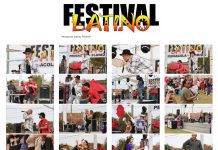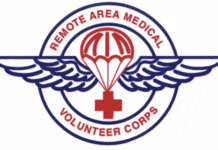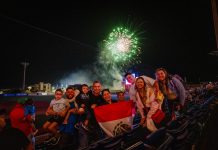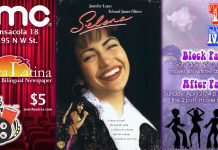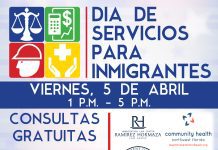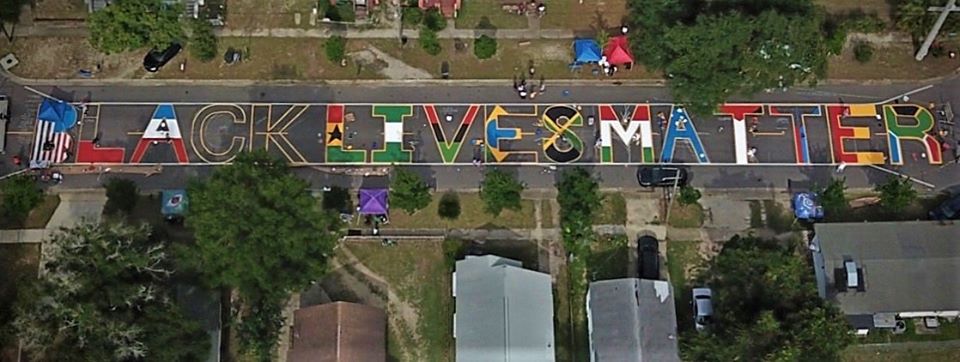
El mural Black Lives Matter en Pensacola cuenta una historia que incluye a México
PENSACOLA, Fla. – La idea de pintar las palabras LAS VIDAS NEGRAS IMPORTAN en toda la calle puede haberse originado en Washington, D.C. y replicarse en varias ciudades despues, pero ninguna es como la pintada en Pensacola.
Dieciséis artistas locales trabajaron juntos para pintar las letras gigantes en la calle A entre las calles Gadsden y Jackson en el centro de Pensacola. Cada letra se llenó con una bandera nacional designada. El resultado fue un mural colorido que cuenta una historia de la historia negra que los organizadores del proyecto de pintura quieren que la gente sepa.
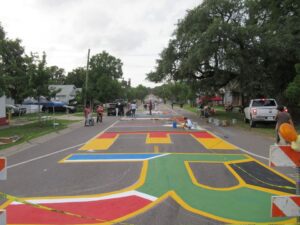 La historiadora local y candidata para del consejo municipal, Teníadé Broughton, fue consultado para seleccionar las banderas y secuenciar las banderas que fueron pintadas. Durante la ceremonia de dedicación del mural, Broughton explicó la historia de la siguiente manera:
La historiadora local y candidata para del consejo municipal, Teníadé Broughton, fue consultado para seleccionar las banderas y secuenciar las banderas que fueron pintadas. Durante la ceremonia de dedicación del mural, Broughton explicó la historia de la siguiente manera:
“Más de 400 ciudades en 50 países realizaron protestas en honor de Black Lives Matter y George Floyd,” dijo Broughton. “Entonces, al llamar la atención a su llamar la atención a nosotros, elegimos algunas de esas banderas. Las banderas nacionales dentro del mural se agrupan conceptualmente para organizar su protesta y se clasifican por cada palabra.”
Broughton continuó explicando el significado de cada bandera en el mural.
“BLACK: El uso de estas banderas, Estados Unidos, España, Francia, Reino Unido y Portugal, sirve como recordatorio de nacionalidad e identidad. En el comercio marítimo, los negros también fueron los primeros identificados para el mercado de los barcos esclavos, barcos que transportaban personas y mercancías durante el comercio. Reconocemos que la génesis del capitalismo americano estaba ligada al trabajo libre de los africanos y los sirvientes por contrato. Pusimos las bases para el sistema capitalista americano porque éramos la capital.
La palabra Negro comienza con la bandera de los Estados Unidos, citando primero a nuestro propio país. Las naciones restantes ilustran países que orquestaron el comercio transatlántico de esclavos y esas naciones se beneficiaron de la venta de personas africanas. La creación de la palabra Negro de las naciones europeas centra la presencia de personas africanas en estos países, y el orden de las banderas, España, Francia, Inglaterra y Estados Unidos, refleja la historia de Pensacola con cuatro de las Cinco Banderas (de Pensacola).
LIVES: Colocada en el centro del mural, la palabra habla a nuestra humanidad y centra la voz de la diáspora africana con la bandera de liberación panafricana como foco. Ghana y Nigeria representan dos naciones de las que nos robaron, mientras que Brasil y Jamaica fueron naciones a las que fuimos llevados durante la esclavitud.
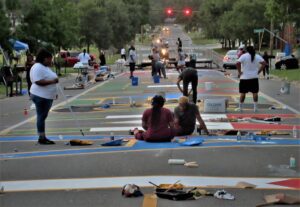 MATTER: Esta agrupación elude a la importancia en su definición obvia como un tema de preocupación, pero también como la sustancia física de la materia y el agua sobre la cual están conectadas las identidades nacionales. En cada ejemplo, las naciones se dividieron socialmente y geopolíticamente. Algunos se han reconciliado, mientras que otros esperan la reconciliación.
MATTER: Esta agrupación elude a la importancia en su definición obvia como un tema de preocupación, pero también como la sustancia física de la materia y el agua sobre la cual están conectadas las identidades nacionales. En cada ejemplo, las naciones se dividieron socialmente y geopolíticamente. Algunos se han reconciliado, mientras que otros esperan la reconciliación.
México es el primero. México figura como el primero por doble razon. Primero, su conexión inmediata con la diáspora africana a menudo se ve como algo separado. Pero los africanos fueron llevados a México desde el siglo XVI y su descendencia todavía vive en el país hasta el día de hoy. Segundo, la frontera mexicana estaba dividida por los Estados Unidos y ahora algunos de los Estados Unidos incluyen algunas de sus fronteras.
Australia, Filipinas y Sudáfrica fueron países controlados por gobiernos minoritarios y gobiernos opresivos. Alemania es uno de los países que tuvo algunas de las mayores protestas por Black Lives Matter al reconocer y comprender que fueron un país una vez dividido durante la Segunda Guerra Mundial, la opresión del pueblo judío durante el Holocausto y el Muro de Berlín, ahora juntos y reconciliados.
En eso, lo comparamos con la historia de Palestina, que todavía está esperando el reconocimiento y la reconciliación como su propia nación. Finalmente, Sudáfrica sirve como un ejemplo de un país que luchó contra el segregación racial, sobrevivió, pudo tener una verdadera reconciliación y ahora el país está trabajando para reconstruirse, lo ha hecho con éxito mientras continúan luchando contra la opresión.
En conjunto, la frase representa el llamado a lo que todos debemos considerar en este momento en la forma en que nos encargamos de cada un, en la forma en que votamos, en la forma en que nos tratamos. La forma más rápida de levantar algo es comenzar levantándolo desde la base. Y cuando decimos Black Lives Matter, no queremos decir que ninguna otra vida importe. Simplemente conocemos las vidas que están en el fondo, una vez que haces que esas vidas importen, entonces todos están elevados.”
El video de cinco minutos de la presentación se puede encontrar en la página de Facebook de La Costa Latina (latinomedia). La Costa Latina organizó una sesión de fotos con la comunidad mexicana en el mural que rodea la letra “M”. La foto también se puede encontrar en su página de Facebook.
Black Lives Matter mural in Pensacola tells a story which includes Mexico
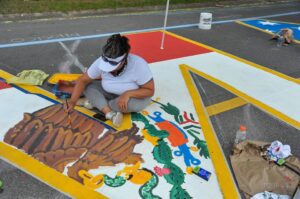 PENSACOLA, Fla. – The idea of painting the words BLACK LIVES MATTER on the entire street block may have originated in Washington, D.C. and replicated in several cities since then, but none are like the one painted in Pensacola.
PENSACOLA, Fla. – The idea of painting the words BLACK LIVES MATTER on the entire street block may have originated in Washington, D.C. and replicated in several cities since then, but none are like the one painted in Pensacola.
Sixteen local artists worked together to paint the giant letters on A Street between Gadsden and Jackson Streets in downtown Pensacola. Each letter was filled with a designated national flag. The result was a colorful mural that tells a story of Black history that organizers of the painting project want people to know.
Local historian and city council member candidate, Teníadé Broughton, was consulted to select the flags and sequence in which the flags were painted. During the dedication ceremony for the mural, Broughton explained the story as follows:
“Over 400 cities in 50 countries held protests in honor of Black Lives Matter and George Floyd,” Broughton said. “So, in calling attention to their calling attention to us, we picked some of those flags. The national flags within the mural are conceptually grouped for hosting their protest and categorized by each word.”
Broughton went on to explain the significance of each flag in the mural.
“BLACK: The use of these flags, the United States, Spain, France, United Kingdom and Portugal, serves as a reminder of nationhood and identity. In maritime commerce, Blacks are also the first identifying markers for the slave ships, ships that carried people and goods during the trade. We recognize that the genesis of American capitalism was tied to the free labor of African people and indentured servants. We laid the foundation for the American capitalist system because we were the capital.
The word Black begins with the United States flag, citing our own country first. The remaining nations illustrate countries that orchestrated the trans-Atlantic slave trade and those nations benefitted from the sale of African people. Creating the word Black from European nations centers the presence of African people in these countries, and the ordering of the flags, Spain, France, England and the United States, reflects Pensacola’s history with four of the Five Flags (of Pensacola).
LIVES: Set at the middle of the mural, the word speaks to our humanity and centers the voice of the African diaspora with the Pan-African liberation flag as its focus. Ghana and Nigeria represent two nations we were stolen from, while Brazil and Jamaica were nations we were taken to during slavery.
MATTER: This grouping eludes to matter in its obvious definition as an issue of concern, but also as the physical substance of matter and water upon which national identities are connected. In each example, the nations were divided socially, and geopolitically. Some have reconciled, while some others await reconciliation.
Mexico is first. Mexico listing as first is twofold. First, it’s immediate connection to the African diaspora is often viewed as separate. But Africans were taken to Mexico as early as the 1500s and their descendants still live in the country today. Second, the Mexican boundary was divided by the United States and now some of the United States includes some of its boundaries.
Australia, the Philippines and South Africa all were countries that were held by minority rule and oppressive governments. Germany is one of the countries that had some of the largest protests for Black Lives Matter in recognizing and understanding that they were a country once divided during WWII, the oppression of Jewish people during the Holocaust and the Berlin Wall, now back together and reconciled.
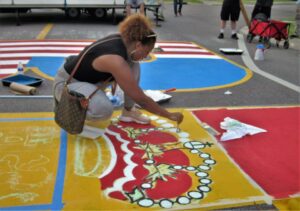 In that, we compare it to the story of Palestine, who is still waiting for recognition and reconciliation as its own nation. Finally, South Africa serves as an example of a country that battled apartheid, survived, was able to have a true reconciliation and now the country is working to rebuild itself has done so successfully as they continue to fight oppression.
In that, we compare it to the story of Palestine, who is still waiting for recognition and reconciliation as its own nation. Finally, South Africa serves as an example of a country that battled apartheid, survived, was able to have a true reconciliation and now the country is working to rebuild itself has done so successfully as they continue to fight oppression.
Together the phrase represents the call for what we all need to be considering right now in the way we deal with each other, in the way that we vote, in the way we treat each other. The quickest way to lift something is to start by lifting it from the bottom. And when we say Black Lives Matter, we don’t mean no other lives matter. We just know the lives that are at the bottom, once you make those lives matter, then everyone is uplifted.”
The five-minute video of the presentation can be found on the La Costa Latina Facebook page (latinomedia). La Costa Latina organized a photoshoot with the Mexican community at the mural surrounding the M. The photo can also be found on their Facebook page.
BLACK
B – Estados Unidos/United States
L – España/Spain
A – Francia/France
C – Inglaterra/England
K – Portugal
LIVES (HUMANITY)
L – Ghana
I – Nigeria
V – Liberación Panafricana/Pan-African Liberation
E – Brasil/Brazil
S – Jamaica
MATTER
M – Mexico
A – Australia/Australia
T – Palestina/Palestine
T – Alemania/Germany
E – Filipinas/Philippines
R – Sudáfrica/South Africa




